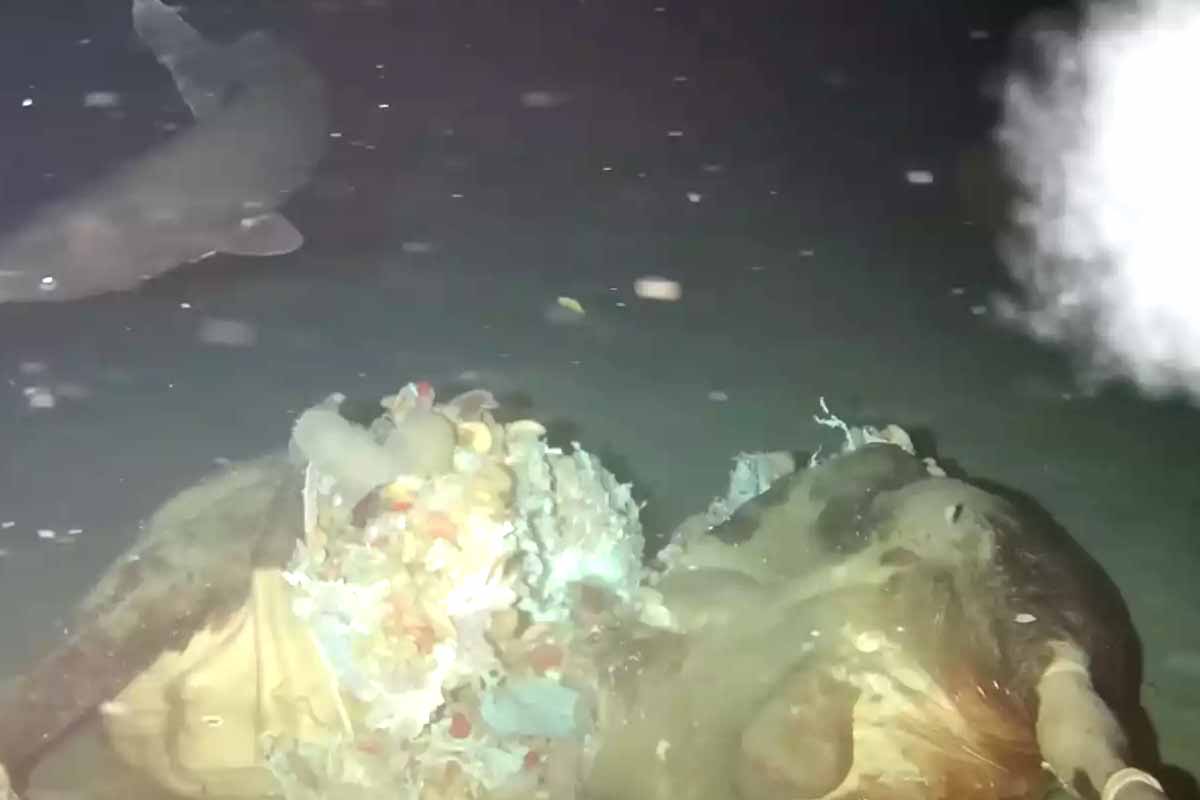Eight shadows slid into the lights as the carcass settled on the slope, and the cameras kept rolling. The team wanted to copy a whale-fall and watch life gather at depth near Hainan’s continental margin. Instead, eight Pacific sleeper sharks arrived, calm yet assertive, in the South China Sea. The footage captured size, tactics, and a first regional record for this elusive species, while it raised new questions about food webs, ranges, and change in the deep.
From Whale-Fall Simulation To Rare Deep-Sea Encounter
The goal was simple: recreate a whale-fall, then record what happens as scavengers assemble and feed in sequence. Because whale carcasses sink rarely on camera, the team used a cow as a practical proxy and lowered it to 1,629 meters, about 5,344 feet, on a continental slope near Hainan Island.
Video confirmed the setup, then revealed eight Pacific sleeper sharks, a surprise for scientists who seldom glimpse this species alive. The sharks moved with measured purpose and minimal haste, yet they coordinated around the carcass with striking order. This encounter, recorded far from the species’ usual cold-water haunts, added a fresh data point for distribution and behavior.
The appearance also showed how a single large food pulse structures a community within minutes. Sharks arrived first and held position, while other scavengers watched the margins for their chance. The scene matched many whale-fall models, and it still challenged assumptions because timing, numbers, and species mix proved richer than expected in the South China Sea basin.
Why These Sharks Appeared In The South China Sea Depths
The footage captured a courteous queue that still followed competitive logic. Sharks in front surrendered the prime spot to newcomers that pressed from behind, which suggests individual intensity decides priority while overt fights stay rare. The flow looked efficient, so feeding time stretched as positions changed without chaos.
Body size also shaped tactics. Individuals at least 2.7 meters long drove the first charges and bit hard, which displayed confidence and strength near the carcass. Smaller sharks circled with care and probed edges before testing the opening. That pattern limited clashes, while it still let each shark gain a fair share.
Behavior aligned with a strategy suited to wide, dim habitats where meetings are brief and costly. Sharks managed risk, because damage in deep water can end future foraging. The queue preserved order; the rotation spread access; the restraint conserved energy. Together, those choices turned a tense meal into a workable truce.
What The Cameras Revealed About Strategy And Safety
Close shots showed an eye-retraction reflex just as jaws flexed around tissue, which matters because these sharks lack a protective third eyelid called a nictitating membrane. Retraction likely shields the eye during thrashing bites, while it reduces injury risk when bone or amphipod swarms scrape the socket.
The sharks carried hitchhikers. Copepod parasites clung to skin and, possibly, the eyes, a burden also noted in the Greenland shark, the species’ Arctic cousin. Parasites may slow vision or irritate tissue, yet deep-sea life copes with trade-offs that favor longevity, stealth, and sparse meals rather than speed or sharp turns.
Other players joined the stage. Snailfish slid along the bottom, and dense clouds of amphipods shredded loose tissue because small scavengers excel at quick work. Their presence, plus the sharks’ drive, hinted at a robust food web. The observed urgency in the South China Sea also implied more deep sources of carrion than once assumed.
Range, Temperature, And Open Questions
Records place Pacific sleeper sharks across the North Pacific, from Japan to Alaska, then south to Baja California and even the Tonga Trench. They usually prefer cold water, which makes warm basins look unlikely. Yet individuals have turned up near the Solomon Islands and Palau, hints of flexibility at depth.
Seeing eight together here prompts two possibilities. The species may always have occupied these waters, and we simply lacked cameras at the right time and place. Or warming layers and shifting currents may expand tolerable zones, while the deep still stays cold enough for slow, bulky predators that value energy savings.
The team flagged the southwestern sector of this basin for frequent detections, which suggests our map of sleeper shark ranges remains patchy. Climate signals could be nudging edges; sampling bias could be the simpler answer. Both options matter because conservation and fisheries need accurate distributions, not assumptions drawn from convenience.
What This South China Sea Sighting Could Mean Next
Method tested, the path ahead looks clear. Researchers can deploy more baited camera drops, then stagger them across seasons to gauge timing, size classes, and repeat visitors. Standardized lighting, angles, and soak times will improve comparisons; careful scent plumes will keep attraction distances consistent for better counts.
Because food pulses shape deep-sea life, scientists could pair cameras with sensors that log oxygen, currents, and temperature layers. Those tracks would link behavior with conditions, while they also reveal whether sharks prefer slopes, canyons, or flatter plains. Short notes in the study already point to promising hotspots in the southwest sector.
Limits remain. A cow mirrors many whale-fall cues, yet it cannot match every texture, lipid profile, or bone density. Even so, controlled replicas unlock patterns that chance rarely shows. With open data and shared protocols, teams can map scavenger networks more quickly, and they can test how ranges shift during fast environmental change.
Why This Deep Encounter Echoes Far Beyond A Single Carcass
The moment eight sleeper sharks lined up at depth, a secret world became legible, and our models sharpened. This event in the South China Sea added behavior, ranges, and food-web hints that lab work alone cannot supply. Because evidence multiplies with repetition, more drops will turn awe into trend lines and useful, protective decisions.
